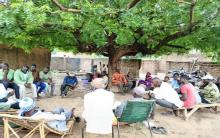Land Library Search
Through our robust search engine, you can search for any item of the over 73,000 highly curated resources in the Land Library.
If you would like to find an overview of what is possible, feel free to peruse the Search Guide.
/ library resources
Showing items 1 through 9 of 53.Le dialogue multi acteurs constitue le principal enjeu pour l’amélioration de la gouvernance foncière de façon générale.
Au Mali, la gouvernance des terres et des ressources naturelles, longtemps fondée sur le principe de la domanialité publique, n’a pas réussi à mieux sécuriser les droits des communautés locales ni à empêcher la dégradation desdites ressources.
Les autorités maliennes ont mis en place des commissions foncières (CoFo) en vue de prévenir et de résoudre les conflits fonciers. Ces commissions sont confrontées à des problèmes de fonctionnement liés au manque de ressources financières.
Land administration and management systems (LAMSs) have already made progress in the field of 3D Cadastre and the visualization of complex urban properties to support property markets and provide geospatial information for the sustainable management of smart cities.
Despite the significant and explicit focus on the United Nations Sustainable Development Goals (SDGs), much of the world’s land rights remain unrecorded and outside formal government systems.
Land is the key asset in the agricultural sector and hence land policy is one of the key elements that determine whether SDGs are achieved in developing counties or not. In developing countries, land titling programs have been seen as a strategy for addressing SDGs.
Most Chinese cities have spent decades achieving urbanisation. So far, rural urbanisation has shifted to urban renewal.
Increasing farmers’ income has always been the core task of China’s land reform. In 2017, a nationwide pilot project on the use of collective construction land for the construction of rental housing was launched.
The large-scale acquisition of land by investors intensified following the 2007/2008 triple crises of food, energy, and finance. In the years that followed, tens of millions of hectares of land were leased or sold for agricultural investment.









